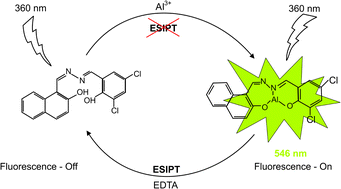A new highly selective “off–on” typical chemosensor of Al3+, 1-((Z)-((E)-(3,5-dichloro-2-hydroxybenzylidene)hydrazono)methyl) naphthalene-2-ol, an experimental and in silico study†
Abstract
A new promising fluorescent chemosensor based on a 2-hydroxynaphthaldehyde skeleton was successfully synthesized through double imine formation as a yellow solid with an overall chemical yield of 63%. The compound showed UV/Visible maxima of at 394 nm in DMSO. Based on spectroscopic data of FTIR, ToF-HRMS, 1H-NMR, and 13C-NMR, the product was characterized as 1-((Z)-((E)-(3,5-dichloro-2-hydroxybenzilydine)hydrazono)methyl)naphthalene-2-ol. Upon experimental study, the compound was confirmed as a highly selective and reversible off–on typical chemosensor against Al3+ with an emission quantum yield of 0.203 ± 0.009. The Job's plot analysis revealed that a highly stable 1:1 complex was formed with an association constant of 8.73 × 105 M−1. A pH-dependent study showed that the sensor was potentially applicable at physiological conditions (pH 7–8) in a mixture of DMSO : H2O (99 : 1, v/v). The LoD and LoQ of the chemosensor towards Al3+ in DMSO were found to be 0.04 and 0.14 μM respectively. Based on DFT and TD-DFT calculation (B3LYP hybrid method/basis set of 6-311+G(d,p)), the sensing mechanism of the chemosensor to the ion was discovered as inhibition of excited-state intramolecular proton transfer (ESIPT).



 Please wait while we load your content...
Please wait while we load your content...